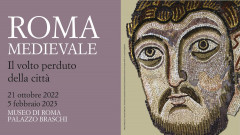Exhibition in Rome: The Lost Middle Ages
In the Museo di Roma (Palazzo Braschi) near the Piazza Navona, a special exhibition on "Roma medievale: Il volto perduto della città" is on show until 5 February. The exhibition is worthwhile for long stretches, but it weakens somewhat the further you go. It begins with the great basilicas of Rome and then deals with topography, everyday life, liturgy, etc. and ends with the medieval vedute of the 19th century. Unfortunately, in many cases only facsimiles are exhibited, but one is used to that by now because of the insurance sums. Original frescoes rescued from churches in the 19th century are important elements of the exhibition.
But the real benefit is only to be had with the very solid catalogue (28 euros), which at the same time also shows which reconstructions and other objects one would actually need as a visitor to the exhibition in order to fully understand it. Sometimes you only see fragments that a non-specialist can only understand with difficulty and place in the whole (for example, the liturgical furnishings or John VII's Lady Chapel in Old St. Peter's).
Otherwise, however, one must praise the exhibition as such. As the preface says, it goes back to the initiative of the Chair of Medieval Art at the Sapienza. It is about the appreciation of a period that almost no longer exists in Rome's inventory of monuments. As is so often the case in art history, the innovators always destroy what precedes them. The Baroque destroyed the Middle Ages and the nationally charged archaeological euphoria about antiquities of the 19th century dealt the final blow to the Middle Ages, so that one would actually have liked to have heard a word of self-criticism about the destruction of the 19th/20th century.
Now one can only warn against the new barbarians who destroy historicism, neo-Romanesque and neo-Gothic with stupid contempt.
- Details
- Written by: Stefan Heid
- Category: Roman notes
 Römisches Institut der Görres-Gesellschaft
Römisches Institut der Görres-Gesellschaft







